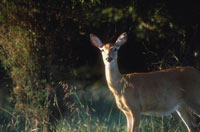TREE TALK
Originally published in Capital on March 29, 2008

Life on the Edge
Is Too Much a Good Thing?
To most people, living on the edge means not putting a raincoat on when it’s raining to get the mail.
Truly living on the edge in this sense is generally left to the bold and brave willing to sacrifice personal safety for the richer experience or an adrenaline rush. Skydiving comes to mind or bungee jumping from bridges. To each their own I suppose.
Living on the edge can have another connotation and that refers to those organisms that spend a lot of their time, if not all of it at the edge of an ecosystem. Called an ecotone or the interface between two distinct types of ecological communities, the edges are where the most diversity is located. White tail deer for example are found more often than not on the edge or border of the forest and not deep within. Basically, and this holds for all animals, there’s more food to be found at the edge of the trees, and if danger approaches they can see the danger easier and they have an easy way to escape by running into the woods.
This goes for other animals too. Rabbits, squirrels, and other small mammals as well as birds are all much more numerous along the forest edge. Food and cover, two of the three basic habitat requirements, the last being water, are again the key. Food and cover is found there for a simple reason. The plants that animals rely on for food, mainly shrubs and small trees, but also the herbaceous plants like grasses and wildflowers need light to grow and more importantly light for flowers that produce the fruits that animals feed on. Most of these trees do grow in the interior reaches of the forest; flowering dogwood is a prime example.
Very shade tolerant, dogwood will grow quite well in the understory in many forest cover types. Good and consistent seed production won’t be found on interior grown dogwoods; they need not full sun but more than just partial sun to flower significantly. Paw Paw is another shade tolerant shrub/small tree that produces more fruit if given more light. Other common woody plants that animals feed on that are commonly found along the forest edge are elderberry, raspberry, wild grape, and most people’s favorite, poison ivy. Not all shrubs that provide food for wildlife are shade intolerant. The low bush blueberry a very common shrub in the oak pine forests in this area produces considerable fruit that wildlife use.
Now, one might think if edge is good for wildlife, why not create more edge? After all the more warm fuzzies there are the better, eh? That’s not necessarily so. One of the main reasons we have an overpopulation of white tail deer is that by carving up the landscape into neat little parcels we have created much more edge and therefore habitat than the carrying capacity can support.
The abundance of edge also affects habitat for those birds that require large blocks of forest for nesting, the forest interior dwelling species, or FIDS for short.
And lastly, the abundant edges we have created are the zone where many of the invasive plant species are causing such havoc - Oriental bittersweet, Japanese honeysuckle and tree of heaven to name a few of the more obnoxious ones. Light is abundant along the edge and these plants know how to take advantage of it.
Sometimes we can’t have our cake and eat it too. Edge habitat is good for wildlife but too much of a good thing is not good, as seen with the whitetail deer; and if having the edge lets in the invasive weeds, that’s not good either. The bottom line is the edge needs to be managed; we need to keep the weeds out and where necessary enhance the existing habitat by planting the trees and shrubs to boost the diversity of the vegetation. But there are no groups out there demonstrating to "Save the Edges". Nevertheless, our work is cut out for us; at least we know where to start.
Note: Baltimore County is holding an Invasive species workshop on April 19th of this year. If interested drop an email to the address below.
Questions and comments can be directed to
ForestGreenway@comcast.net
Bud Reaves writes Tree Talk for the Anne Arundel County Forest Conservancy
District Board.
Photograph of